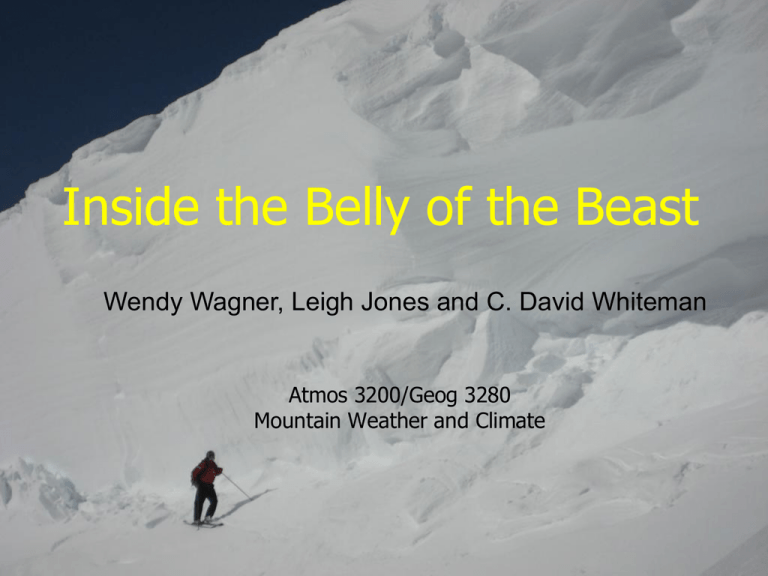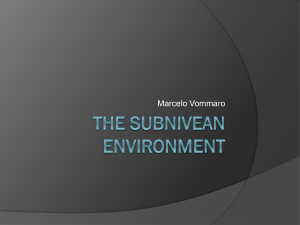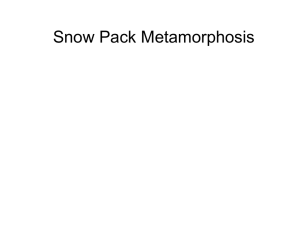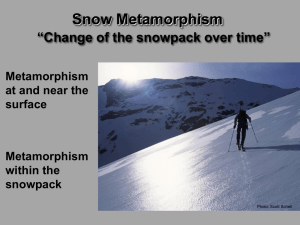17.Wagner_Snowpack
advertisement

Inside the Belly of the Beast Wendy Wagner, Leigh Jones and C. David Whiteman Atmos 3200/Geog 3280 Mountain Weather and Climate Mountain Snowpack Beauty Ripp’n it in the Wasatch or Beast? © Tim Lane Recap - Snow Formation and Accumulation How do we grow snow? 1 - Vapor Deposition 2 - Accretion 3 - Aggregation What does crystal type depend on? 1- Temperature 2- Supersaturation © Kenneth G. Libbrecht SnowCrystals.com New Snow - SLR (Snow Liquid Ratio) Volume water 10 cm^3 X 100 = 10% Volume snow 100 cm^3 Baxter et al. 2005 Mountain Snowpack - Diversity Creep and glide - Snow Deformation © F. Baker McClung and Schaerer (1993) Accumulating a Snowpack Snow pack layering – Character of fallen snow initially defines the layering in the snowpack – The snowpack can be transformed by wind action even after snowfall has stopped. Location of wind deposited snow depends on terrain. Jim Steenburgh in 15’ snowpit Ben Lomond Snowpack Densities SWE/depth ratio Percent density Snow density Cold new snow <.04 <4% <40kg/m3 Average snowpack ~0.20 ~20% ~200kg/m3 Very dense snowpack 0.40 40% 400kg/m3 Slalom race course 0.60 60% 600kg/m3 Pure ice 0.917 91.7% 917kg/m3 Water 1.0 100% 1000kg/m3 Snowpack Physical Characteristics Snowpack density (can vary for different layers) Albedo – Solar reflectivity – Fresh snow >0.9 – Wet snow 0.6 Snowpack temperature profile – In temperate zones, the snowpack-ground interface is maintained throughout the winter very close to the melting point of 0°C. – The snowpack temperature gradient is determined by the thickness of the snowpack and snow surface temperature What’s Inside the Belly of the Beast? Snowpack Stratigraphy is a record of meteorology/climate. Sequence of weak/strong layers and binding between layers – Wind strength and direction – Number and intensity of storms – rain – Solar and longwave radiation – Temperature, melting, humidity, pressure Center for Snow and Avalanche Studies Snowpack Temperature Profile Isothermal? Weak temperature gradient? Strong temperature gradient? Snowpack Metamorphism Changes in the snowpack due to heat flow and pressure Three types of snowpack metamorphism: – Equitemperature – rounded grains (strong snow) – Temperature-gradient – faceted grains (weak snow) – Melt-freeze – rain water or melt water, percolation, undergoes diurnal melt and freeze cycles. (weak in melt phase, strong in frozen phase) ***The temperature gradient of a snow layer determines the type of metamorphism while the temperature determines the rate of metamorphism Snow Temperature Profile and Snow Metamorphism Barchet 1978 Equitemperature Metamorphism *** Weak temperature gradient < 10ْ C / m Sintering - formation of bonds between snow grains There is a tendency for water vapor to evaporate from convex surfaces and condense at concave surfaces where grains touch to form necks. Perla & Martinelli (1975) Equitemperature Metamorphism AKA: – Sintering – Rounding – Destructive metamorphism Settlement cones Grain is decreasing its surface area to volume ratio => surface area/volume Snow grain metamorphism (at constant temperature) by curvature effects. The time in days in given in the lower right. Equitemperature Metamorphism Growth rates of snow grains within a snowpack Low grain growth rates – The colder the temperature the slower the growth rate – The weaker the temperature gradient the slower the growth rate Produces more bonds per unit volume and greater strength in the snowpack USDA Electron Microscopy Snow Unit Temperature Gradient Metamorphism *** Strong temperature gradient The critical temperature gradient to produce faceted forms in alpine snowpacks is > 10°C / m. AKA: – Faceting – Kinetic growth – Constructive metamorphism Growth by vapor diffusion from areas of relatively high vapor pressures (temperatures) to low vapor pressures (temperatures). Perla & Martinelli (1975) Minimal grain bonding Temperature Gradient Metamorphism www.avalanche.org Depth Hoar USDA Electron Microscopy Snow Unit Radiation Recrystalization Also called: Near surface faceting Faceting near or on the surface of the snowpack due to a temperature gradient induced by absorbed solar radiation Peak in snow temperature occurs 2-5cm below the snow surface (Morstad, Adams and McKittrick 2004) Temperature Gradient Metamorphism Growth rates of snow grains within a snowpack High grain growth rates – The stronger the temperature gradient the higher the growth rate – The warmer the temperature the higher the growth rate – The larger the pore space size the higher the growth rate Grains produced under high growth rates (surface hoar, depth hoar, faceted snow, radiation recrystallization) form weak, unstable snow that is often responsible for serious avalanche conditions. Metamorphic Forms LaChapelle (1962) Temperature Gradients – Different Climates Maritime climate: usually, temperatures are mild and snowpacks are deep so that there are weak temperature gradients and warm temperatures in the snowpack. Continental climate: thinner snowpacks and colder air temperatures produce large temperature gradients. This leads, more often, to faceted snow crystals in the snowpack and buried layers of instability. Intermountain climate: deeper snowpack than continental climates so temperature gradients are lower, yet they still can exist and lead to snowpack instability. Surface Hoar Faceted crystals formed by deposition onto the snowpack surface when water vapor pressure in the air exceeds the equilibrium vapor pressure over ice at the surface. The crystals usually form when – a sufficient supply of water vapor is present in the air – a high temperature gradient (inversion) is present above the snow surface. ***Thus surface hoar usually forms on cold, clear nights with calm or nearly calm conditions (common in continental climates). USFS (1968) Surface hoar may be inhibited in concave areas of the snow surface and under trees Eastern Sierra Avalanche Center Surface Hoar Surface hoar is extremely fragile and easily destroyed by sublimation, wind, melt-freeze cycles, and freezing rain. When buried in the snowpack, a surface hoar layer is extremely efficient in propagating shear instabilities (fractures). Surface hoar may gain strength by bond formation with adjacent layers, but thick layers may persist for months within the snowpack. www.avalanche.org Melt-Freeze Metamorphism Warm snowpacks have variable amounts of liquid water – Water-saturated snow (slush; water content > 15% by volume) – Very wet snow (8-15% by volume) – Wet snow (3-8%, water cannot be pressed out by gentle hand squeezing, but a meniscus of water occurs between grains) – Moist (<3%; snow sticks together to make a snowball). Strength of wet snow decreases with increasing water content. Small particles have a lower melting temperature than larger ones, so they melt first. The heat of melting comes from larger particles, which undergo surface re-freezing (release of heat) and an increase in size; corn snow!! Melt-Freeze Metamorphism Sun crusts At low water contents, clusters of grains form near the snowpack surface where melting and freezing cycles can occur. After night cooling this combination produces very strong crusts composed of frozen grain clusters that lose almost all their strength after midday heating. Perla &Martinelli (1975) www.avalanche.org Snowpack Layering Bruce Tremper, Utah Avalanche Center Exposing the Belly of the Beast Avalanches… Bill Gallagher







